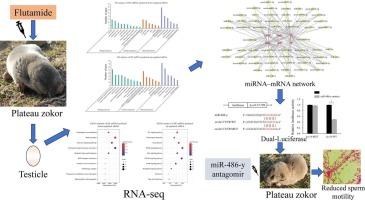Analysis of miRNA expression profiles during spermatogenesis of plateau zokor (Eospalax baileyi) under androgen antagonism treatment
IF 2.2
2区 生物学
Q4 BIOCHEMISTRY & MOLECULAR BIOLOGY
Comparative Biochemistry and Physiology D-Genomics & Proteomics
Pub Date : 2025-09-13
DOI:10.1016/j.cbd.2025.101636
引用次数: 0
Abstract
Seasonal reproduction in animals is characterized by programmed activation, dormancy of reproductive activities, and precise regulation of hormone levels. Androgens secreted by Leydig cells are essential for testicular development and spermatogenesis. To explore the mechanism of androgen in spermatogenesis in seasonal breeding animals, this study used the plateau zokor (Eospalax baileyi) as a model and, during the breeding season, treated it with the androgen receptor antagonist, flutamide, to analyze its effect on the microRNA (miRNA) expression profile in testicular tissue. Flutamide treatment resulted in marked changes in the expression of 91 miRNAs in the testes (28 upregulated and 63 downregulated), including 44 known and 47 newly predicted miRNAs. Functional enrichment analysis of the target genes of differentially expressed miRNAs demonstrated significantly enriched cell adhesion, hypoxia response, apoptosis process, inflammatory response, lipid metabolism (Gene Ontology analysis, P < 0.05) and ferroptosis, fatty acid metabolism and other signaling pathways (Kyoto Encyclopedia of Genes and Genomes analysis, P < 0.05). Based on this, an interaction network of miRNA–mRNA in the spermatogenesis and ferroptosis pathways was constructed. Dual-luciferase reporter gene assay confirmed that ACSL4 was a direct target gene of miR-486-y. The expression of miR-486-y was inhibited by an antagomir, which verified its involvement in the regulation of spermatogenesis in the plateau zokor during reproduction. Androgens regulate spermatogenesis in plateau zokors by inhibiting specific miRNAs (such as miR-486-y). This study provides molecular evidence and new perspectives on the regulatory network of seasonal reproduction in animals.

雄激素拮抗作用下高原鼢鼠精子发生过程中miRNA的表达谱分析。
动物的季节性繁殖以程序化的激活、繁殖活动的休眠和激素水平的精确调节为特征。睾丸间质细胞分泌的雄激素对睾丸发育和精子发生至关重要。为探讨雄激素在季节性繁殖动物精子发生中的作用机制,本研究以高原鼢鼠(Eospalax baileyi)为模型,在繁殖季节用雄激素受体拮抗剂氟他胺处理,分析其对睾丸组织microRNA (miRNA)表达谱的影响。氟他胺治疗导致睾丸中91个mirna的表达发生显著变化(28个上调,63个下调),其中包括44个已知mirna和47个新预测的mirna。差异表达的miRNAs靶基因功能富集分析显示,细胞粘附、缺氧反应、凋亡过程、炎症反应、脂质代谢等功能显著富集(基因本体分析,P
本文章由计算机程序翻译,如有差异,请以英文原文为准。
求助全文
约1分钟内获得全文
求助全文
来源期刊
CiteScore
5.10
自引率
3.30%
发文量
69
审稿时长
33 days
期刊介绍:
Comparative Biochemistry & Physiology (CBP) publishes papers in comparative, environmental and evolutionary physiology.
Part D: Genomics and Proteomics (CBPD), focuses on “omics” approaches to physiology, including comparative and functional genomics, metagenomics, transcriptomics, proteomics, metabolomics, and lipidomics. Most studies employ “omics” and/or system biology to test specific hypotheses about molecular and biochemical mechanisms underlying physiological responses to the environment. We encourage papers that address fundamental questions in comparative physiology and biochemistry rather than studies with a focus that is purely technical, methodological or descriptive in nature.

 求助内容:
求助内容: 应助结果提醒方式:
应助结果提醒方式:


